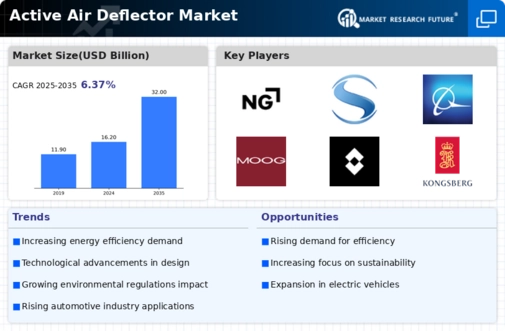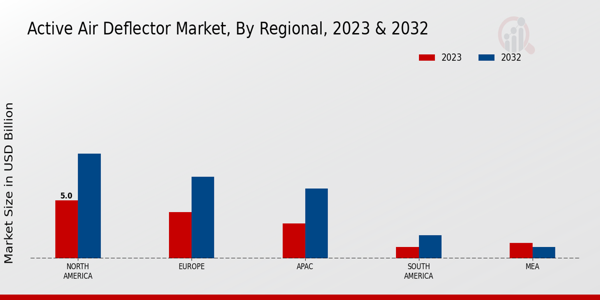Market Growth Projections
The Global Active Air Deflector Market Industry is poised for substantial growth, with projections indicating a market size of 16.2 USD Billion in 2024 and an anticipated increase to 32.0 USD Billion by 2035. This growth trajectory is underpinned by a compound annual growth rate (CAGR) of 6.37% from 2025 to 2035. The increasing focus on energy efficiency, technological advancements, and regulatory support are key factors driving this expansion. As industries and consumers alike recognize the benefits of active air deflectors in enhancing air quality and reducing energy costs, the market is expected to flourish in the coming years.
Rising Demand for Energy Efficiency
The Global Active Air Deflector Market Industry experiences a notable surge in demand driven by the increasing emphasis on energy efficiency across various sectors. As organizations strive to reduce operational costs and minimize environmental impact, the adoption of active air deflectors becomes more prevalent. These devices enhance airflow management, thereby optimizing energy consumption in heating, ventilation, and air conditioning systems. In 2024, the market is projected to reach 16.2 USD Billion, reflecting a growing recognition of the importance of energy-efficient solutions. This trend is likely to continue as industries seek to comply with stringent regulations aimed at reducing carbon emissions.
Expansion of the Construction Sector
The expansion of the construction sector serves as a significant driver for the Global Active Air Deflector Market Industry. As new buildings are constructed, there is a growing need for efficient air management systems that can ensure optimal climate control and energy efficiency. Active air deflectors are increasingly integrated into modern building designs to enhance HVAC performance. This trend is particularly pronounced in regions experiencing rapid urbanization and infrastructure development. The construction industry's growth is expected to bolster the demand for active air deflectors, further contributing to the market's expansion in the coming years.
Growing Awareness of Indoor Air Quality
The Global Active Air Deflector Market Industry is significantly influenced by the rising awareness of indoor air quality among consumers and businesses alike. With a growing understanding of the health impacts associated with poor air quality, there is an increasing demand for solutions that enhance ventilation and air circulation. Active air deflectors are recognized for their ability to improve air distribution, thereby contributing to healthier indoor environments. This trend is particularly evident in commercial buildings, where regulations regarding air quality are becoming more stringent. As a result, the market is poised for growth, with projections indicating a potential market size of 32.0 USD Billion by 2035.
Technological Advancements in Air Management
Technological innovations play a pivotal role in shaping the Global Active Air Deflector Market Industry. The integration of smart technologies, such as IoT and AI, into air management systems enhances the functionality and efficiency of active air deflectors. These advancements enable real-time monitoring and adjustment of airflow, leading to improved indoor air quality and energy savings. As these technologies become more accessible, their adoption is expected to rise, contributing to market growth. The anticipated CAGR of 6.37% from 2025 to 2035 indicates a robust trajectory for the industry, as stakeholders increasingly invest in advanced air management solutions.
Regulatory Support for Energy Efficiency Initiatives
Regulatory frameworks promoting energy efficiency initiatives are instrumental in driving the Global Active Air Deflector Market Industry. Governments worldwide are implementing policies and incentives aimed at reducing energy consumption and promoting sustainable practices. These regulations often encourage the adoption of advanced technologies, including active air deflectors, as part of broader energy management strategies. As businesses seek to comply with these regulations, the demand for energy-efficient solutions is likely to rise. This supportive regulatory environment is expected to facilitate market growth, aligning with the projected increase in market size to 32.0 USD Billion by 2035.









